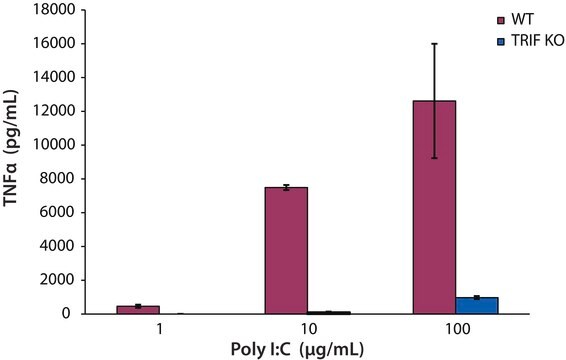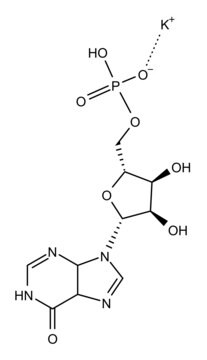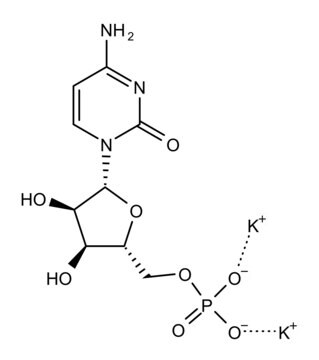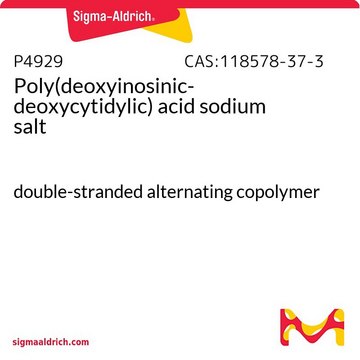528906
Polyinosinic Acid • Polycytidylic Acid, Sodium Salt, Double-Stranded
Known to induce interferon production. Hypochromicity: ≥40% at 248 nm. Extinction coefficient = 5000 M-1cm-1 at 260 nm, pH 7.0.
Synonim(y):
Poli I - poli C, Na
About This Item
Polecane produkty
Poziom jakości
opis
RTECS - TR0175000
Próba
≥99% (TLC)
Formularz
powder
producent / nazwa handlowa
Calbiochem®
warunki przechowywania
OK to freeze
kolor
white
rozpuszczalność
aqueous buffer: 10 mg/mL
water: soluble
Warunki transportu
ambient
temp. przechowywania
−20°C
ciąg SMILES
[Na].[P](=O)(OC[C@H]3O[C@H]([C@@H]([C@@H]3O)O)[n]4c5ncnc(c5nc4)O)(O)O.[P](=O)(OC[C@H]1O[C@H]([C@@H]([C@@H]1O)O)N2C=CC(=NC2=O)N)(O)O
InChI
1S/C10H13N4O8P.C9H14N3O8P.Na/c15-6-4(1-21-23(18,19)20)22-10(7(6)16)14-3-13-5-8(14)11-2-12-9(5)17;10-5-1-2-12(9(15)11-5)8-7(14)6(13)4(20-8)3-19-21(16,17)18;/h2-4,6-7,10,15-16H,1H2,(H,11,12,17)(H2,18,19,20);1-2,4,6-8,13-14H,3H2,(H2,10,11,15)(H2,16,17,18);/t
Klucz InChI
GETQKWBYQAUFQM-VRQAYDGLSA-N
Opis ogólny
Zastosowanie
- Penaeus monodon Interferon Regulatory Factor (PmIRF) Activates IFNs and Antimicrobial Peptide Expression via a STING-Dependent DNA SensingPathway: Badanie to bada rolę PmIRF w odpowiedziach immunologicznych krewetek, w szczególności sposób, w jaki aktywuje on interferony i peptydy przeciwdrobnoustrojowe poprzez zależną od STING ścieżkę wykrywania DNA, wzmacniając obronę przeciwwirusową. (Soponpong et al., 2021).
- Identyfikacja, profilowanie ekspresji TLR8 karpia trawnego i jego hamowanie prowadzące do odporności na reowirusa w komórkach CIK...: Niniejszy artykuł koncentruje się na receptorze TLR8 u karpia trawnego, jego profilach ekspresji i sposobie, w jaki jego zahamowanie nadaje odporność na reowirusa w liniach komórkowych ryb, zapewniając wgląd w odporność przeciwwirusową u gatunków wodnych. (Chen et al., 2013).
- Identyfikacja i profile ekspresji genu ADAR1, odpowiedzialnego za edycję RNA, w odpowiedzi na dsRNA i GCRV u karpia trawnego (Ctenopharyngodon idella)...: Badanie bada gen ADAR1 zaangażowany w edycję RNA u karpi trawiastych, podkreślając jego odpowiedź na dwuniciowe RNA i reowirusa karpi trawiastych, rzucając światło na mechanizmy odpornościowe ryb. (Yang et al., 2012).
- Aktywacja immunologiczna i uszkodzenie narządów docelowych są konsekwencjami leczenia hydrodynamicznego, ale nie dostarczania nagich siRNA u myszy...: Badania te różnicują skutki leczenia hydrodynamicznego i dostarczania nagich siRNA u myszy, wykazując, że aktywacja immunologiczna i uszkodzenie narządów są związane z metodą leczenia, a nie z samymi siRNA. (Rácz et al., 2011).
Ostrzeżenie
Rekonstytucja
Informacje prawne
Kod klasy składowania
11 - Combustible Solids
Klasa zagrożenia wodnego (WGK)
WGK 3
Temperatura zapłonu (°F)
Not applicable
Temperatura zapłonu (°C)
Not applicable
Certyfikaty analizy (CoA)
Poszukaj Certyfikaty analizy (CoA), wpisując numer partii/serii produktów. Numery serii i partii można znaleźć na etykiecie produktu po słowach „seria” lub „partia”.
Masz już ten produkt?
Dokumenty związane z niedawno zakupionymi produktami zostały zamieszczone w Bibliotece dokumentów.
Klienci oglądali również te produkty
Nasz zespół naukowców ma doświadczenie we wszystkich obszarach badań, w tym w naukach przyrodniczych, materiałoznawstwie, syntezie chemicznej, chromatografii, analityce i wielu innych dziedzinach.
Skontaktuj się z zespołem ds. pomocy technicznej








